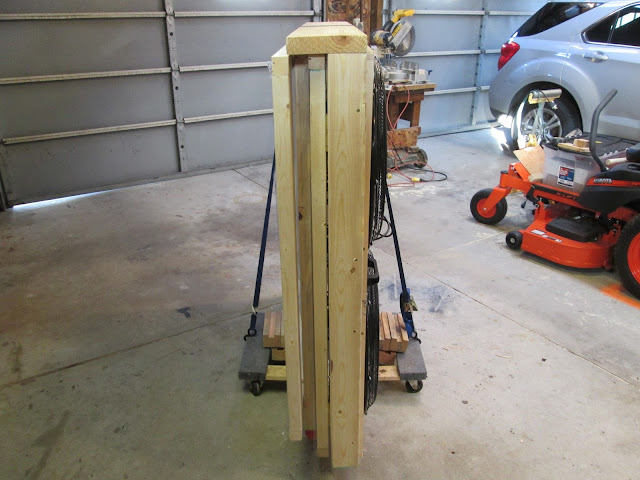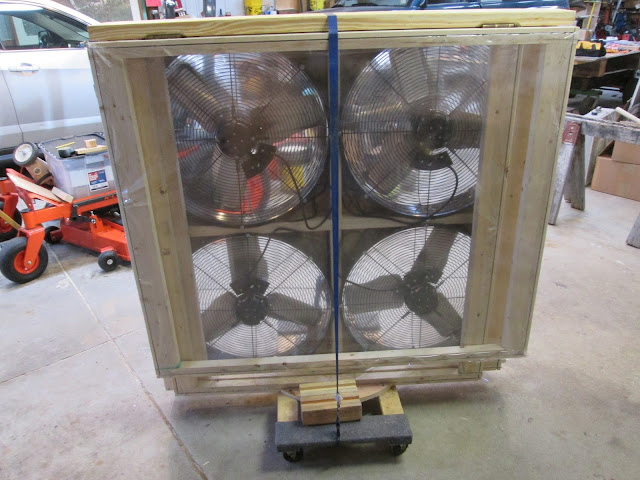Lets get started...
First thing is to read and study the blueprint and all the notes to get familiar with the design details.
BACK FRAME
Cut and assemble the Back Frame first. This will be the part that attaches to the barn fan. The Side and Top Frames will be hinged to this.
Cut List -
1 - 2 x 8 - 51" Long
1 - 2 x 6 - 48" Long (Note: This is ripped from the other half of the 10' - 2 x 8 board)
2 - 2 x 4 - 48" Long
1 Piece if 3/4" CDX Plywood - this plywood is attached inside the frame and then the hole for the fan played out and cut. You will also have to notch out an area for the wheels on the fan to fit in.
Back Frame Drawing
Cut and assemble the TWO Side Frames
Cut List for TWO Side Frames -
4 - 2 x 4 - 48" Long
2 - 2 x 2 - 40" Long
Side Frames and Top Frame Drawings
Cut and assemble One Top Frame
Cut List for ONE Top Frame -
2- 2 x 4 - 36" Long
2 - 2 x 2 - 51" Long
BACK FRAME
Cut and assemble the Back Frame first. This will be the part that attaches to the barn fan. The Side and Top Frames will be hinged to this.
Cut List -
1 - 2 x 8 - 51" Long
1 - 2 x 6 - 48" Long (Note: This is ripped from the other half of the 10' - 2 x 8 board)
2 - 2 x 4 - 48" Long
1 Piece if 3/4" CDX Plywood - this plywood is attached inside the frame and then the hole for the fan played out and cut. You will also have to notch out an area for the wheels on the fan to fit in.
Cut and assemble the TWO Side Frames
Cut List for TWO Side Frames -
4 - 2 x 4 - 48" Long
2 - 2 x 2 - 40" Long
Side Frames and Top Frame Drawings
Cut and assemble One Top Frame
Cut List for ONE Top Frame -
2- 2 x 4 - 36" Long
2 - 2 x 2 - 51" Long
Attaching 8 mil plastic to frames
Heavy picture frame mate strips are hot glued to the 8 mil plastic and then rolled so that the plastic is wrapped around the mate strip. Then the strip is stapled to the outside of the Top and Side frames.
Since the picture frame mate material is thicker than tag board I used a band saw to cut the 1/2" wide strips I needed.
Working from the middle out the first side is stapled through the plastic and mate strip material. Then do the same on the opposite side drawing the plastic tight. Repeat the process for the remaining two sides.
This is the finished product. By the time you do three of these you should have the hang of it!
Assemble the TOP FRAME to the BACK FRAME with hinges mounted on the inside as shown. It is important to attach the top frame first because it places the hinges and they can now be measured so clearance notches for them can be cut into the top of each SIDE FRAME.
Locate, mark and cut the clearance notches for the hinges in the FIRST SIDE FRAME. Then attach the SIDE FRAME to the BACK FRAME with hinges on the inside. HINT - Rotate the assembled frames around so that each time the plastic covered frame is on the floor when the hinges are attached. Locate, mark and cut the clearance notches for the hinges in the SECOND SIDE FRAME and attach with hinges.
And here is what you should now have. Notice I have added a pull strap to the FIRST SIDE FRAME. This is needed to pull the frame out when setting it up. NOTE: In this photo the 3/4" plywood brace where the wheel will be is on the wrong edge of the 2x4 and no notch for the wheel has been cut yet. Also note that the triangle pieces are now a single piece of 4' by 4' CDX plywood.
A hole was drilled for the pin (a 16d duplex nail) that holds the SIDE FRAMES in place when swung out. NOTE the FIRST SIDE FRAME is short of the TOP FRAME this is necessary so that the FISRT SIDE FRAME will fold completely inside for storage.
Also I have added two 2x4 feet to the bottom of the BACK FRAME to stabilize the unit when it is folded up for storage. NOTE: These should be 2 x 4 scraps, longer and on both sides. The 2x2 piece on each side acts as a handle. There is a removable pin that holds the SECOND SIDE FRAME in place. The draw hasp catch has not been installed yet in this photo but they will go right below each 2x2 handle.
Here the clasps are mounted and the shroud is pulled tight to the barn fan. This shroud could be used on larger or smaller diameter fans you would just have to modify the size of the corner braces and alignment for the clasps. Turn buckles could also be used instead of clasps.
And here you can see the shroud disconnected from the fan, folded up and neatly stored out of the way under a set of stairs ready to be pulled out for the next wind tunnel testing of a set of blades and wind turbine for a Kid Wind Challenge.
I welcome any questions or comments on this design if you are making one of these. Thanks
Heavy picture frame mate strips are hot glued to the 8 mil plastic and then rolled so that the plastic is wrapped around the mate strip. Then the strip is stapled to the outside of the Top and Side frames.
Since the picture frame mate material is thicker than tag board I used a band saw to cut the 1/2" wide strips I needed.
Working from the middle out the first side is stapled through the plastic and mate strip material. Then do the same on the opposite side drawing the plastic tight. Repeat the process for the remaining two sides.
This is the finished product. By the time you do three of these you should have the hang of it!
Assemble the TOP FRAME to the BACK FRAME with hinges mounted on the inside as shown. It is important to attach the top frame first because it places the hinges and they can now be measured so clearance notches for them can be cut into the top of each SIDE FRAME.
Locate, mark and cut the clearance notches for the hinges in the FIRST SIDE FRAME. Then attach the SIDE FRAME to the BACK FRAME with hinges on the inside. HINT - Rotate the assembled frames around so that each time the plastic covered frame is on the floor when the hinges are attached. Locate, mark and cut the clearance notches for the hinges in the SECOND SIDE FRAME and attach with hinges.
And here is what you should now have. Notice I have added a pull strap to the FIRST SIDE FRAME. This is needed to pull the frame out when setting it up. NOTE: In this photo the 3/4" plywood brace where the wheel will be is on the wrong edge of the 2x4 and no notch for the wheel has been cut yet. Also note that the triangle pieces are now a single piece of 4' by 4' CDX plywood.
A hole was drilled for the pin (a 16d duplex nail) that holds the SIDE FRAMES in place when swung out. NOTE the FIRST SIDE FRAME is short of the TOP FRAME this is necessary so that the FISRT SIDE FRAME will fold completely inside for storage.
Also I have added two 2x4 feet to the bottom of the BACK FRAME to stabilize the unit when it is folded up for storage. NOTE: These should be 2 x 4 scraps, longer and on both sides. The 2x2 piece on each side acts as a handle. There is a removable pin that holds the SECOND SIDE FRAME in place. The draw hasp catch has not been installed yet in this photo but they will go right below each 2x2 handle.
Here the clasps are mounted and the shroud is pulled tight to the barn fan. This shroud could be used on larger or smaller diameter fans you would just have to modify the size of the corner braces and alignment for the clasps. Turn buckles could also be used instead of clasps.
And here you can see the shroud disconnected from the fan, folded up and neatly stored out of the way under a set of stairs ready to be pulled out for the next wind tunnel testing of a set of blades and wind turbine for a Kid Wind Challenge.
I welcome any questions or comments on this design if you are making one of these. Thanks
























































